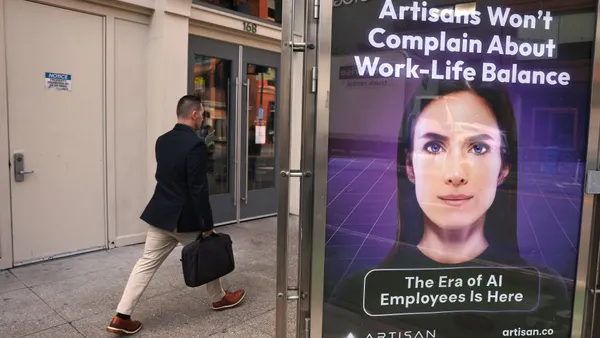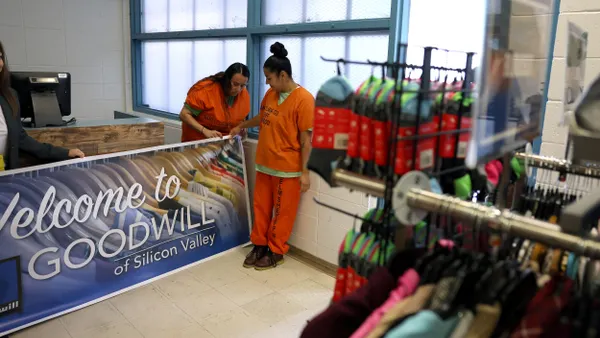After a years-long rush to find talent, hiring has been pushed to back burner, according to data from HR Dive’s Identity of HR 2024 survey.
2024’s rocky start may have been one of the first signals that the market was in for a change. Big-name tech companies including Snap, Amazon, Google and Microsoft all announced massive waves of layoffs, prompting widespread concern that the long-rumored recession may be around the corner.
The job market stabilized, however, and experts told HR Dive at the time that those layoffs were largely a righting of a ship made wobbly by years of extensive overhiring in tech fields, particularly in response to the pandemic.
Hiring pushed to the back burner
But HR folks — caught in the mire of shifting priorities — say they now face not only tighter budgets but higher expectations for maximizing those dollars
In last year’s Identity of HR survey, 24% of survey respondents, a plurality, said hiring was their top priority, followed closely by culture. In this year’s survey, hiring dropped to third place on the list, beaten out by “maximizing value within budgetary constraints,” the answer cited by 26% of the 490 respondents surveyed. Culture was once again in second place at 22%.
Maximizing value and improving culture top HR priorities
As the pendulum swings back to something more like normalcy, “it might feel like a step back,” Jonathan Gove, senior executive advisor at Eagle Hill Consulting, told HR Dive. But now employers — for the first time in years — may finally feel like they have the right people in place, just in time for HR to focus intently on value.
An imbalance righting itself
Budget patterns were tied to this imbalance, according to Hanne Nieberg, director analyst within Gartner's HR Practice.
HR budgets saw a more than 60% increase in 2020, right before COVID-19 hit, according to Gartner data. Once the pandemic struck, budgets locked down enormously to adjust for uncertainty. By 2022, spending had increased, only for the “triple squeeze” of supply chain constraints, labor shortages and inflation to hamstring budgets all over again in 2023.
Only 40% of leaders surveyed by Gartner said they aim to increase their budgets for 2024, while 30% said budgets would hold steady and 30% said they would be decrease, Nieberg said. Notably, staffing and recruiting dropped from second place priority in investment to seventh.
Overhiring during the pandemic may have influenced this, Nieberg said; now, companies are saying “we want to grow with the talent that we have.”
“Retention is likely to be the higher priority,” Gove said, as employers maximize the talent they have in-house already.
Where should HR invest?
When budgets are tight, HR professionals may need to shift some of their tasks back into the business function to free up resources, Nieberg said. For example, some HR functions screen resumes; in a lower budget period, some organizations may opt to offload that task onto hiring managers to free up space for higher priorities.
Employers also can leverage technology to manage some of that offloading, she added. Many tools feature employee self-service options that could save HR workers a great deal of time. But while technology is continuously rated as the No. 1 way to increase efficiency and reduce costs in the HR function, according to Gartner data, tech also rarely achieves the intended effect of its adoption, Nieberg said.
“Inflated expectations” around tech are likely the culprit, she said. And sometimes, employees simply don’t use it, especially if it isn’t explained well.
“I think what we are trying to help folks do is not lose sight of employee experience despite budget pressures,” Gove said. Identifying good tools is a part of that process, but it isn’t the whole process. “The forward-thinking HR leaders are getting ahead of that” by looking for tech that can help their teams not only with efficiency but engagement, he added.
When times are tight, HR leaders may be especially focused on prioritization. “Always [be] identifying critical talent, making sure your limited resources are being deployed to that group in particular,” Gove said.
Learning and development may be a big part of that reinvestment, Gove added. Tech adoption can be an opportunity to extend L&D regarding product improvements and technical skill sets to workers, which has historically helped retention.
But generally, HR may have the opportunity to free up budget typically reserved for lower value-added areas, like payroll and HR administration, and move it to L&D and total rewards, Nieberg said.
“Compensation is still the No. 1 reason an employee is taking or leaving a job,” Nieberg said. For employers that can’t afford big raises, offering more interesting career opportunities, such as the opportunity to move horizontally in the business and gain new skills, can go a long way for workers and employers both, she added.
Recognition is also huge, Gove said. Employee resource groups, a sense of camaraderie and skill building “can be especially valued in this market.”
A time for experimentation
One silver lining of a less liquid talent market — fewer departures, less hiring — is that it is “not a bad time to try things that require a leap of faith,” Gove said. If people are not looking as actively for new jobs, employers may find it “a good time to invest in tech training or reskilling that in other times might be seen as ruffling feathers.”
Employers may also be more willing to experiment with — and perhaps enforce — the return to the office in such an environment, Gove said. “We might see more of that coming” during these improved times of retention, he added.
Above all, employers should be transparent — both by listening to what employees have to say and by being clear about why an organization may have chosen a certain approach to something, Gove said.
“Find out what it is that employees will value or would like to see … and build something aligned with their wants and needs,” he said.















